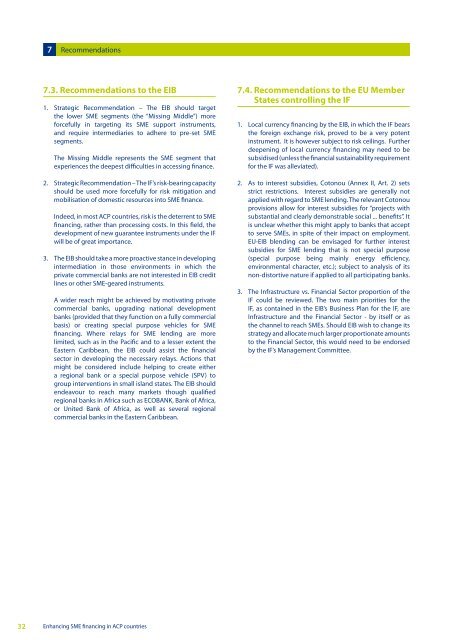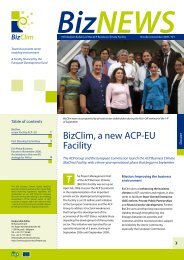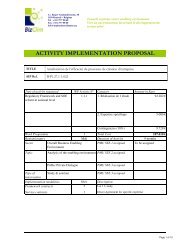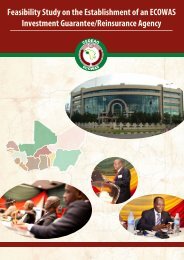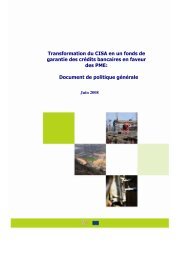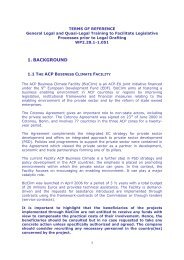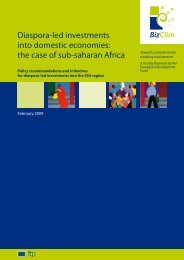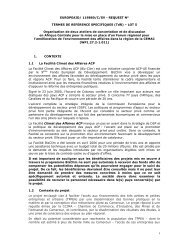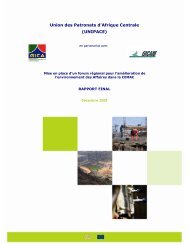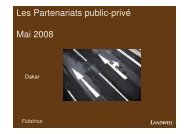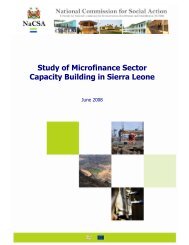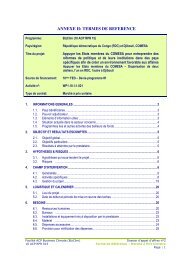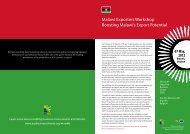Enhancing smE financing in acp countries - ACP Business Climate
Enhancing smE financing in acp countries - ACP Business Climate
Enhancing smE financing in acp countries - ACP Business Climate
Create successful ePaper yourself
Turn your PDF publications into a flip-book with our unique Google optimized e-Paper software.
7<br />
Recommendations<br />
7.3. Recommendations to the EIB<br />
1. Strategic Recommendation – The EIB should target<br />
the lower SME segments (the “Miss<strong>in</strong>g Middle”) more<br />
forcefully <strong>in</strong> target<strong>in</strong>g its SME support <strong>in</strong>struments,<br />
and require <strong>in</strong>termediaries to adhere to pre-set SME<br />
segments.<br />
The Miss<strong>in</strong>g Middle represents the SME segment that<br />
experiences the deepest difficulties <strong>in</strong> access<strong>in</strong>g f<strong>in</strong>ance.<br />
2. Strategic Recommendation – The IF’s risk-bear<strong>in</strong>g capacity<br />
should be used more forcefully for risk mitigation and<br />
mobilisation of domestic resources <strong>in</strong>to SME f<strong>in</strong>ance.<br />
Indeed, <strong>in</strong> most <strong>ACP</strong> <strong>countries</strong>, risk is the deterrent to SME<br />
<strong>f<strong>in</strong>anc<strong>in</strong>g</strong>, rather than process<strong>in</strong>g costs. In this field, the<br />
development of new guarantee <strong>in</strong>struments under the IF<br />
will be of great importance.<br />
3. The EIB should take a more proactive stance <strong>in</strong> develop<strong>in</strong>g<br />
<strong>in</strong>termediation <strong>in</strong> those environments <strong>in</strong> which the<br />
private commercial banks are not <strong>in</strong>terested <strong>in</strong> EIB credit<br />
l<strong>in</strong>es or other SME-geared <strong>in</strong>struments.<br />
A wider reach might be achieved by motivat<strong>in</strong>g private<br />
commercial banks, upgrad<strong>in</strong>g national development<br />
banks (provided that they function on a fully commercial<br />
basis) or creat<strong>in</strong>g special purpose vehicles for SME<br />
<strong>f<strong>in</strong>anc<strong>in</strong>g</strong>. Where relays for SME lend<strong>in</strong>g are more<br />
limited, such as <strong>in</strong> the Pacific and to a lesser extent the<br />
Eastern Caribbean, the EIB could assist the f<strong>in</strong>ancial<br />
sector <strong>in</strong> develop<strong>in</strong>g the necessary relays. Actions that<br />
might be considered <strong>in</strong>clude help<strong>in</strong>g to create either<br />
a regional bank or a special purpose vehicle (SPV) to<br />
group <strong>in</strong>terventions <strong>in</strong> small island states. The EIB should<br />
endeavour to reach many markets though qualified<br />
regional banks <strong>in</strong> Africa such as ECOBANK, Bank of Africa,<br />
or United Bank of Africa, as well as several regional<br />
commercial banks <strong>in</strong> the Eastern Caribbean.<br />
7.4. Recommendations to the EU Member<br />
States controll<strong>in</strong>g the IF<br />
1. Local currency <strong>f<strong>in</strong>anc<strong>in</strong>g</strong> by the EIB, <strong>in</strong> which the IF bears<br />
the foreign exchange risk, proved to be a very potent<br />
<strong>in</strong>strument. It is however subject to risk ceil<strong>in</strong>gs. Further<br />
deepen<strong>in</strong>g of local currency <strong>f<strong>in</strong>anc<strong>in</strong>g</strong> may need to be<br />
subsidised (unless the f<strong>in</strong>ancial susta<strong>in</strong>ability requirement<br />
for the IF was alleviated).<br />
2. As to <strong>in</strong>terest subsidies, Cotonou (Annex II, Art. 2) sets<br />
strict restrictions. Interest subsidies are generally not<br />
applied with regard to SME lend<strong>in</strong>g. The relevant Cotonou<br />
provisions allow for <strong>in</strong>terest subsidies for “projects with<br />
substantial and clearly demonstrable social ... benefits”. It<br />
is unclear whether this might apply to banks that accept<br />
to serve SMEs, <strong>in</strong> spite of their impact on employment.<br />
EU-EIB blend<strong>in</strong>g can be envisaged for further <strong>in</strong>terest<br />
subsidies for SME lend<strong>in</strong>g that is not special purpose<br />
(special purpose be<strong>in</strong>g ma<strong>in</strong>ly energy efficiency,<br />
environmental character, etc.); subject to analysis of its<br />
non-distortive nature if applied to all participat<strong>in</strong>g banks.<br />
3. The Infrastructure vs. F<strong>in</strong>ancial Sector proportion of the<br />
IF could be reviewed. The two ma<strong>in</strong> priorities for the<br />
IF, as conta<strong>in</strong>ed <strong>in</strong> the EIB’s Bus<strong>in</strong>ess Plan for the IF, are<br />
Infrastructure and the F<strong>in</strong>ancial Sector - by itself or as<br />
the channel to reach SMEs. Should EIB wish to change its<br />
strategy and allocate much larger proportionate amounts<br />
to the F<strong>in</strong>ancial Sector, this would need to be endorsed<br />
by the IF’s Management Committee.<br />
32<br />
<strong>Enhanc<strong>in</strong>g</strong> SME <strong>f<strong>in</strong>anc<strong>in</strong>g</strong> <strong>in</strong> <strong>ACP</strong> <strong>countries</strong>


